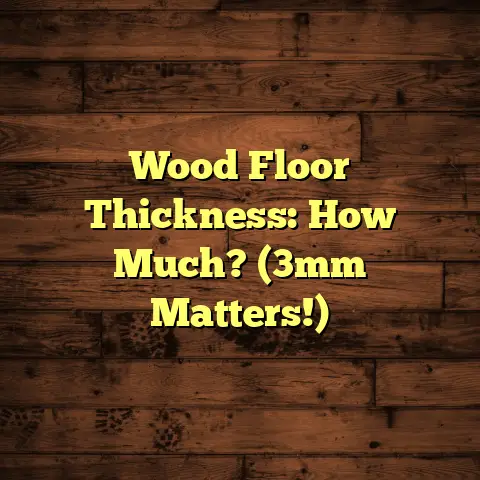Heated Floor Under Vinyl? (6 Install Rules Shock!)
I’m a flooring contractor, and I’ve seen it all.
From disastrous DIY attempts to stunning, flawless installations, I’ve been on the front lines of the flooring revolution.
And lately, the question I get asked most is: “Can I put a heated floor under my vinyl?”
The answer is YES, but it’s not as simple as laying down some wires and slapping vinyl on top.
Trust me, I’ve seen what happens when you skip steps or use the wrong materials – it’s not pretty (or cheap to fix!).
Let’s talk about the magic of heated floors.
Imagine stepping out of bed on a chilly morning and feeling warmth under your feet instead of that dreaded cold shock.
That’s the beauty of radiant floor heating.
And it’s not just about comfort.
Heated floors can actually save you money in the long run. I’m talking reduced energy bills, increased home value, and a level of cozy that’s hard to beat.
Think about it: kitchens and bathrooms become inviting havens, and your entire home just feels more luxurious.
But here’s the deal: installing heated floors under vinyl requires a specific approach.
There are rules you absolutely MUST follow to ensure safety, efficiency, and the longevity of your system.
I’m going to walk you through those rules, debunk some common myths, and give you the inside scoop on how to do it right.
Ready to dive in? Let’s get started!
Section 1: Understanding Heated Floors
So, what exactly are heated floors?
Simply put, they’re systems that radiate heat from the floor upwards, warming the room from the ground up.
Think of it like sunshine on a cool day – it’s warm, gentle, and incredibly comfortable.
There are two main types of heated floor systems:
-
Electric: These systems use electric cables or mats installed under the flooring to generate heat. They’re generally easier to install, making them a popular choice for smaller areas or DIY projects.
-
Hydronic: These systems circulate hot water through pipes embedded in the floor. They’re more energy-efficient for larger areas, but the installation is more complex and usually requires a professional.
Now, let’s talk benefits. We already touched on comfort, but the energy efficiency is a HUGE selling point.
Traditional heating systems often waste energy by heating the air near the ceiling, while the floor stays cold.
Heated floors, on the other hand, provide even heat distribution, allowing you to lower your thermostat and save money.
I’ve seen homeowners slash their heating bills by 15-20% simply by switching to heated floors!
According to the U.S. Department of Energy, radiant floor heating can be more efficient than baseboard heating and can sometimes be more efficient than forced-air heating because it eliminates duct losses. U.S. Department of Energy
And the best part?
Heated floors are compatible with a wide range of flooring types, including tile, stone, laminate, and (you guessed it!) vinyl.
Section 2: The Compatibility of Vinyl Flooring with Heated Systems
So, why is vinyl flooring such a popular choice for homes with heated floors?
Several reasons:
First, vinyl is a great conductor of heat.
It warms up quickly and efficiently, allowing the heat from the system to radiate into the room.
Second, it’s durable and water-resistant, making it ideal for bathrooms and kitchens where heated floors are most commonly installed.
Third, vinyl is relatively affordable, making it a budget-friendly option for homeowners looking to upgrade their floors.
But not all vinyl is created equal.
When it comes to heated floors, you need to be careful about the type of vinyl you choose.
There are two main types:
-
Rigid Core Vinyl (SPC/WPC): This type is more stable and less prone to expansion and contraction due to temperature changes. It’s an excellent choice for heated floors.
-
Flexible Vinyl: This type is more susceptible to expansion and contraction, which can lead to warping or buckling if the temperature is not properly controlled.
I always recommend rigid core vinyl for heated floor applications. It’s simply more reliable and less likely to cause problems down the road.
Now, let’s talk temperature limits.
This is crucial.
Most vinyl flooring manufacturers have specific temperature recommendations for heated floor systems.
Exceeding those limits can damage the vinyl and void your warranty.
Generally, the surface temperature of the vinyl should not exceed 85°F (29°C).
Always check the manufacturer’s instructions for both the heating system and the vinyl flooring before installation.
Section 3: The 6 Installation Rules for Heated Floors Under Vinyl
Alright, let’s get to the heart of the matter: the 6 installation rules that will make or break your heated floor project.
Pay close attention, because these are non-negotiable!
Rule 1: Choose the Right System
As I mentioned earlier, you have two main options: electric and hydronic.
For vinyl flooring, electric systems are generally the more practical choice, especially for smaller areas.
They’re easier to install and offer precise temperature control.
Hydronic systems, while more energy-efficient for larger areas, require a more complex installation and may not be the best fit for vinyl.
The key is compatibility.
Make sure the heating system you choose is specifically designed for use with vinyl flooring.
Read the manufacturer’s specifications carefully and don’t hesitate to ask questions.
I’ve seen too many homeowners make the mistake of choosing the wrong system and ending up with costly repairs.
Rule 2: Proper Subfloor Preparation
This is HUGE.
A properly prepared subfloor is essential for the performance and longevity of your heated floor system.
Here’s what you need to do:
-
Leveling: The subfloor must be perfectly level. Any bumps or dips will create uneven heating and can damage the vinyl over time. Use a self-leveling compound to smooth out any imperfections.
-
Cleaning: Remove all dust, dirt, and debris from the subfloor. This will ensure proper adhesion of the heating system and the vinyl flooring.
-
Insulation: Consider adding a layer of insulation beneath the heating system to prevent heat loss to the subfloor. This will improve the efficiency of the system and save you money on energy bills.
I often use a thin layer of foam insulation board for this purpose.
It’s affordable, easy to install, and makes a big difference in the overall performance of the system.
Rule 3: Maintain Manufacturer Guidelines
I can’t stress this enough.
You MUST follow the manufacturer’s instructions for both the heating system and the vinyl flooring.
These instructions are there for a reason.
They outline the specific requirements for installation, temperature settings, and maintenance.
Ignoring them can void your warranty and lead to serious problems down the road.
I’ve seen homeowners skip steps or use the wrong adhesives, thinking they know better than the manufacturer.
Trust me, it never ends well.
Read the instructions carefully, follow them to the letter, and don’t be afraid to ask for clarification if you’re unsure about anything.
Rule 4: Use an Appropriate Underlayment
Underlayment is a thin layer of material that sits between the subfloor and the vinyl flooring.
It provides a number of benefits, including:
-
Insulation: Underlayment adds an extra layer of insulation, further improving the efficiency of the heating system.
-
Soundproofing: It helps to reduce noise transmission, making your home quieter and more comfortable.
-
Cushioning: It provides a slightly softer feel underfoot, which can be especially appreciated in areas where you stand for long periods of time.
When choosing an underlayment for heated floors, look for one that is specifically designed for this purpose.
These underlayments are typically made from materials that are heat-resistant and won’t interfere with the performance of the heating system.
I often recommend using a thin layer of cork underlayment.
It’s a natural, sustainable material that provides excellent insulation and soundproofing.
Rule 5: Monitor Temperature Settings
This is where temperature control systems come in.
These systems allow you to precisely control the temperature of your heated floor, preventing it from overheating and damaging the vinyl.
I highly recommend investing in a programmable thermostat that allows you to set different temperatures for different times of the day.
For example, you might want to set a lower temperature when you’re away from home and a higher temperature when you’re home and awake.
It’s also important to regularly monitor the surface temperature of the vinyl to ensure it’s not exceeding the manufacturer’s recommendations.
You can use an infrared thermometer for this purpose.
Simply point the thermometer at the floor and it will give you an instant temperature reading.
Rule 6: Professional Installation vs. DIY
This is a tough one.
On the one hand, DIY projects can save you money.
On the other hand, installing heated floors is a complex process that requires specialized knowledge and skills.
If you’re not comfortable working with electricity or plumbing, I strongly recommend hiring a professional installer.
A professional will have the experience and expertise to ensure that the system is installed correctly and safely.
They will also be able to troubleshoot any problems that may arise during the installation process.
I’ve seen too many DIY projects go wrong, resulting in costly repairs and frustrated homeowners.
If you do decide to go the DIY route, be sure to do your research, follow the manufacturer’s instructions carefully, and don’t be afraid to ask for help when you need it.
Section 4: Troubleshooting Common Issues
Even with the best planning and installation, problems can sometimes arise.
Here are some common issues and how to address them:
-
Uneven Heating: This can be caused by a number of factors, including an uneven subfloor, improper installation of the heating system, or insufficient insulation.
- Solution: Check the subfloor for levelness, ensure the heating system is properly installed, and add insulation if necessary.
-
Vinyl Warping: This can occur if the temperature of the heated floor is too high or if the vinyl is not properly adhered to the subfloor.
- Solution: Lower the temperature of the heated floor and ensure the vinyl is properly adhered to the subfloor.
-
Adhesive Failure: This can happen if the wrong adhesive is used or if the subfloor is not properly prepared.
- Solution: Use the adhesive recommended by the vinyl flooring manufacturer and ensure the subfloor is clean and dry before applying the adhesive.
-
Cold Spots: This can be caused by damaged heating elements or improper wiring.
- Solution: Inspect the heating system for damage and repair or replace any faulty components.
Regular maintenance is also key.
Inspect the system periodically for any signs of damage or wear and tear.
Clean the vinyl flooring regularly to prevent dirt and debris from accumulating.
Conclusion
Heated floors under vinyl are a fantastic combination.
They offer unparalleled comfort, energy savings, and a touch of luxury to your home.
But remember, success hinges on following those 6 crucial installation rules.
Choose the right system, prepare the subfloor meticulously, adhere to manufacturer guidelines, use appropriate underlayment, monitor temperature settings, and carefully consider whether to DIY or hire a pro.
By following these guidelines, you’ll be well on your way to enjoying the warmth and comfort of heated floors under your beautiful vinyl.
So, are you ready to transform your living spaces?
I hope this guide has given you the confidence and knowledge to make it happen.
Happy flooring!





